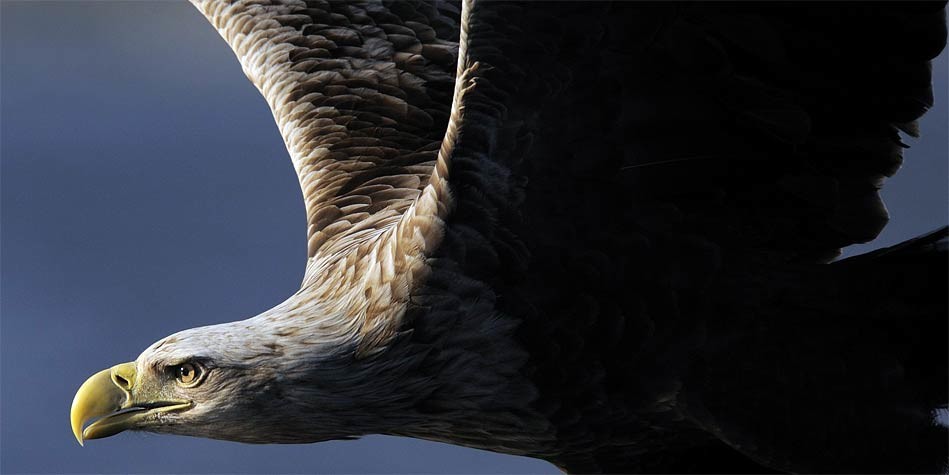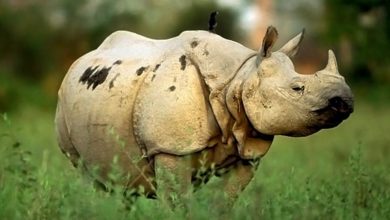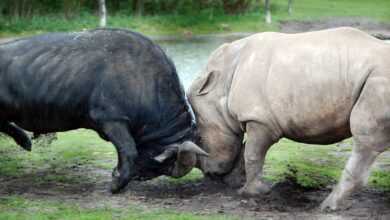White-tailed eagle (Haliaeetus albicilla)
There was a time when this bird was on the verge of extinction. Nonetheless, 20 years ago it rose like a Phoenix and its population became one of the most numerous among the birds of prey of Eurasia. The white-tailed eagle does not stand out with white feathers of the head, like the rest of the relatives from the Haliaeetus genus, it has a white tail.
Classification
- Class: Aves
- Order: Acciptriformes
- Family: Accipitridae
- Subfamily: Accipitrinae
- Genus: Haliaeetus
- Species: White-tailed eagle (Haliaeetus albicilla)
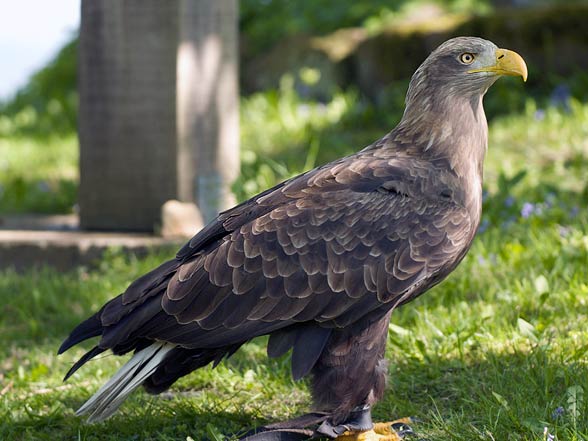
Occurrence
It occurs in northern Europe and northern Asia. The biggest European population occurs alongside the coasts of Norway. Although the bird likes a cold climate, the specimens from eastern Scandinavia and Siberia migrate to the south when the winter comes.
White-tailed eagles from eastern Russia rarely migrate to Alaska. Small populations may occur as well on southwest Greenland and on western Iceland. It may be found in Denmark, Sweden, Poland, and Germany.
Few specimens may occur in the Middle East, China, India, and Mongolia. In 1916, the White-tailed eagle became extinct in Great Britain. It came back to life in the 1970s on Rhum Island and the Inner Hebrides.
It lives on the large, open spaces in the river valleys and on the territories rich in lakes, in the temperate and cold climates (tundra). It prefers the areas near the rocks and rich in large trees suitable for nesting. It likes the secluded places.
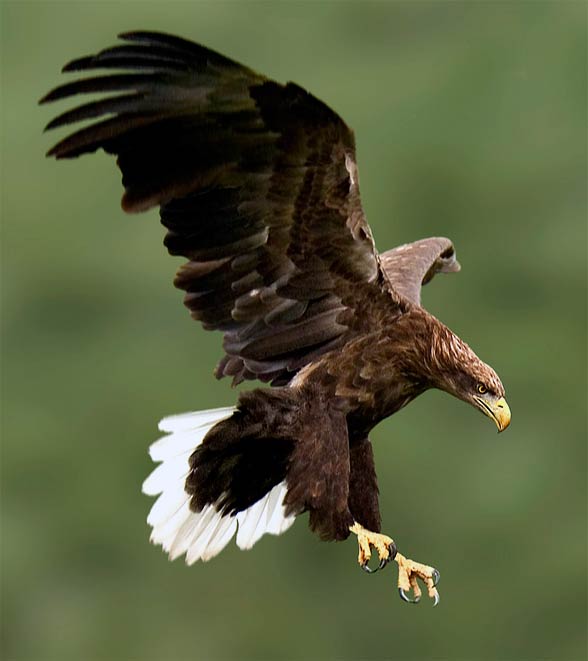
Characteristics
Appearance
White-tailed eagle is a large bird achieving the length of 66 cm to 94 cm (26” – 37”), the wingspan of 1,78 m to 2,45 m (6 – 8 ft) and the weight of 3,1 kg to 6,9 kg (6 lb – 15 lb). Despite the fact, that the Steller’s sea eagle (Haliaeetus pelagicus) is generally heavier and longer, their wingspan is more or less the same.
White-tailed eagle has very broad wings, a large head, and a strong, broad beak.
Plumage
Its plumage is mainly grey-brown, with the exception of lighter head and neck, black flight feathers and white, wedge-shaped tail. The skin around the eyes, the beak, and the limbs are yellow. The juveniles have a darker tail and beak. Their wings are grey-brown.
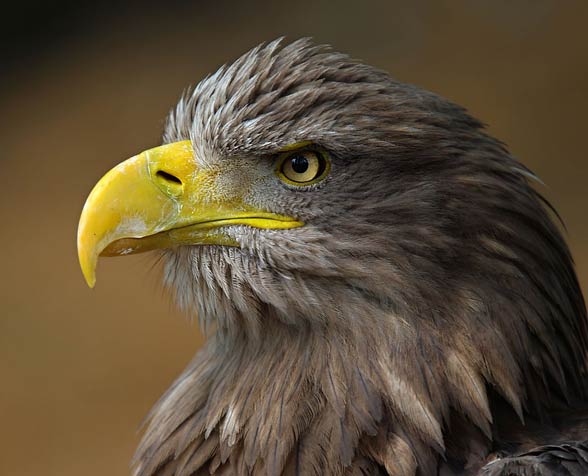
Vocalizations (sounds)
The white-tailed eagle may be heard much more often than the golden eagle (Aquila chrysaetos). It emits sounds that resemble barking, yelling and yelping. The combination of such sounds with a majestic appearance is a bit grotesque.
Territory
It lives on territories measuring from 30 to 70 square kilometers, usually near a water body. The territory may be shared with the golden eagle. They do not tend to compete, as the golden eagle prefers mountains and heaths while the White-tailed eagle prefers the coastal areas, especially the cliffs.
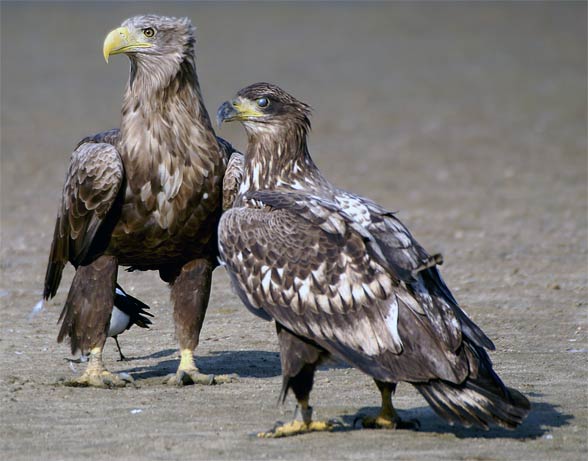
Diet and hunting
Menu
Its menu changes with the season and is various. It often hunts for fish (for example pikes), birds and mammals. Many specimens eat carrion as well. They tend to steal the food from other animals, for example, otters or other birds, including cormorants, gulls, ospreys (Pandion haliaetus).
White-tailed eagle does not hesitate to steal the food from other birds of prey.
During the winter season, when there is little fresh food, the bird eats the carrion of the ungulates and the fish. It may as well consume a dead whale or even a human’s dead body.
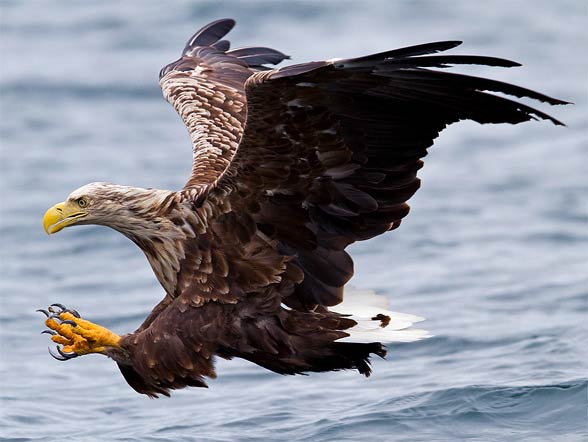
On its own territory, it is a dominant scavenger and hunter. It needs 500 g (1 lb) – 600 g (1.3 lb)
of food daily. However, it is less active hunter than the golden eagle.
It likes fish, therefore the ponds abundant with fish often constitute its target.
The specimens living by the Baltic Sea prefer eating sea birds – the little tern (Sternula albifrons) and the great skua (Stercorarius skua).
It may quite often catch the chicks and the eggs of other birds. It may be sadistic towards its preys, especially towards the water birds – it forces them to dive into the water several times and when they are exhausted, it attacks them.
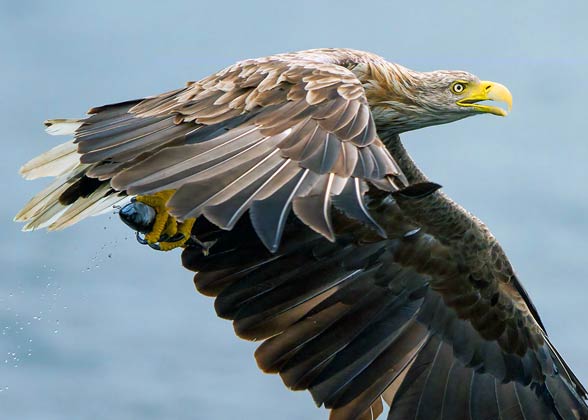
It is able to kill a swan, however it would not be able to lift with such a big prey, therefore it drags it to the shore and then eats it.
It catches mammals of different sizes: for example voles, lambs and deer calves.
Hunting
It hunts in a similar way to other birds from the Accipitridae family. It seats high in the trees or flies around above the hunting territory, and once it notices its prey, it dives towards it and catches it with its talons.
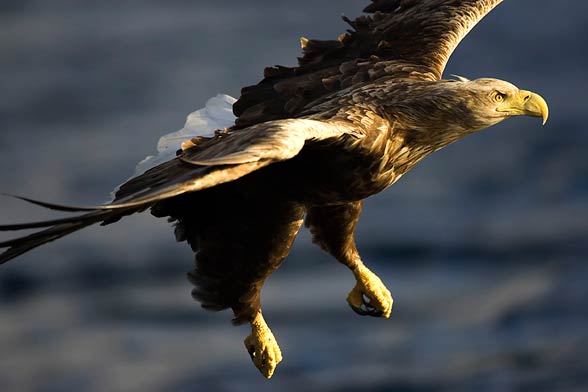
Reproduction
It is a monogamist, therefore it makes a pair for life. However, when one of the partners dies, the second immediately finds another partner. The bond between the birds becomes stronger when they choose their own territory together. While mating, they perform characteristic acts and at the end, they hold their talons and swirl together in a spectacular way. They are much louder than the golden eagle, especially during the breeding season. Sometimes a female and a male emit sounds together.
Nest
White-tailed eagles’ nest is enormous. It is built on the rocks or the tree. As the pair lives in one place for whole life, the nest is used for years or decades and several generations may live in it.
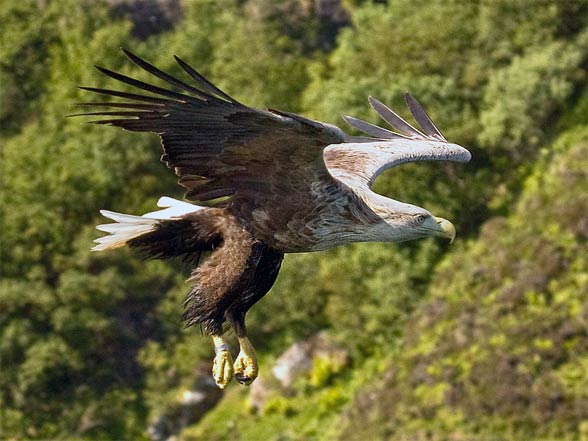
Juveniles
A female lays one to three eggs at an interval of two or four days. The clutch takes place in March or April, the incubation lasts approx. 37 days. Both father and mother incubate eggs.
After the chicks hatch, they tolerate each other. However, the first-born is usually bigger and dominates during feeding which is done mainly by the female. After five to six weeks, the chicks are able to feed themselves. After eleven to twelve weeks, they fledge. They stay near the nest for another six to ten weeks.

Reintroduction
The surplus of eggs is taken from the nests where the biggest numbers of eggs were laid. It is then used to introduce the birds to other territories, where the genus became extinct. Although it may seem a bit cruel, sometimes this way the younger chick can be saved from famine or fratricide.
During reintroduction, the birds are raised in special cages located in the trees. They are feed in such a way that they are not able to see who feeds them. When the chicks learn to fly, they start to find their food by themselves. They become sexually mature when they are five or six years old.

The population of White-tailed eagle in Poland
At the beginning of the 20th century, there were only 20 breeding pairs in Poland. In the 1950s, there were already 49 – 56 breeding pairs. Between the 1960s and 1970s, there were already 100 of them. However, in the 1970s the population decreased due to DDT that was contained in the animals that were eaten by the White-tailed eagle. At the beginning of the 1990s, there were 223 breeding pairs and in 2008, there were already 767 of them. The population increased by 68 %.
Thanks to this success, Poland is the third country in Europe (after Norway and Russia) in terms of number of individuals nesting.
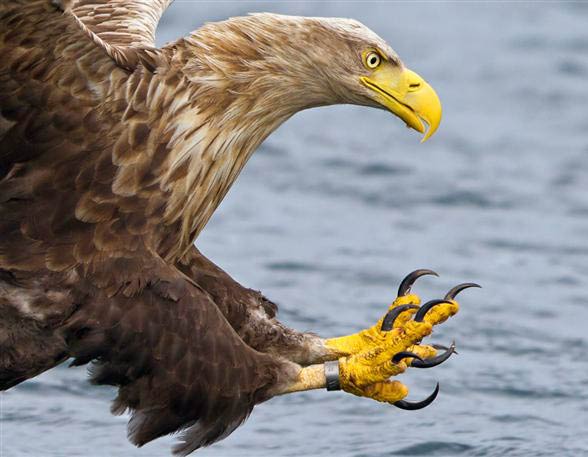
Detailed information / size
White-tailed eagle (Haliaeetus albicilla)
- Body length: 66 cm – 94 cm (26” – 37”)
- Wingspan: 1,78 m – 2,45 m (5 ft 10in – 8 ft)
- Wing length: 55,2 cm – 71,7 (21.7” – 28.2”)
- Tail length: 25 cm – 33 (9.8”- 13”)
- Tarsus length: 9,2 cm – 10,1 cm (3,6” – 4”)
- Beak length: 6 – 6,5 cm (2,3” – 2,5”)
- Weight: females: 4 – 6,9 kg (8.8 – 15.2 lb) males: 3,1 – 5,4 kg (6.8 – 11.9 lb)
- Lifespan: 21 years (maximum 25 years)

White-tailed eagle – curiosities
- The white-tailed eagle is a close cousin of the bald eagle (Haliaeetus leucocephalus).
- The specimens from Greenland are bigger than those from other populations. In the beginning they were supposed to become a species of the White-tailed eagle, however, further analysis indicated that the bigger size was connected to the Bergmann rule.
- White-tailed eagle is often considered the fourth biggest representative of the family Accipitridae in the world.
- The white-tailed eagle is the biggest representative of the family Accipitridae in Europe.
- Because these birds use one nest for generations, in Iceland was found the structure used for 150 years! In Scandinavia, however, under the influence of the great mass of the nest, it collapsed the tree.
- The white-tailed eagle is a national bird of Germany. It is believed that the image of this predator is also visible on the Polish emblem and coat of arms of Serbia.
- In Orkney (Scottish archipelago of islands), found a cluster of bones of these birds in burials of people, which means that white-tailed eagles were venerated by prehistoric peoples of the island. Another proof of this is the stone sculptures depicting images of birds.
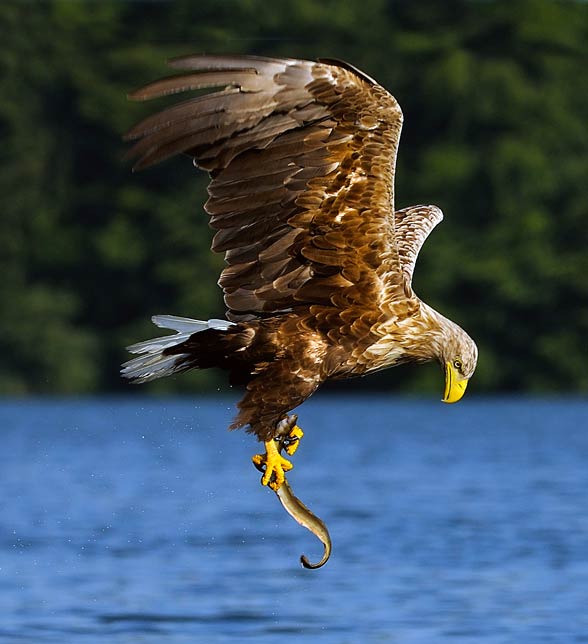
Recommended
- Argentavis
- Eagles
- Animals records
- Largest eagles Top10
- Largest birds of prey Top10
- Haast’s eagle
- Bald eagle
- Black eagle
- Steller’s sea eagle
- Philippine eagle
- Crowned eagle
- Martial eagle
- Wedge-tailed eagle
- Eastern imperial eagle
- Steppe eagles
- Bearded vulture
- Fastest animals – Top 10
- Fastest birds – Top 10
- Highest (Top) flying bird – Top 10
- Largest and heaviest birds

